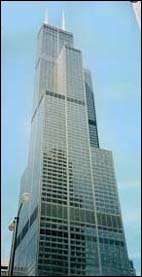Skyscraper Facts

From the father of the skyscraper to a building with a view
by Karen Barss
 The Eiffel Tower, in Paris, France Related Links |
The Eiffel Tower
The Eiffel Tower was the tallest building in the world when it was completed in 1889. It was built for the World's Fair to demonstrate that iron could be as strong as stone while being dramatically lighter. And in fact the wrought-iron tower is twice as tall as the masonry Washington Monument and yet it weighs 70,000 tons less! It is repainted every seven years with 50 tons of dark brown paint.
The Home Insurance Building
Called "the father of the skyscraper," the Home Insurance Building, constructed in Chicago in1885 (and demolished in 1931), was 138 feet tall and 10 stories. It was the first building to effectively employ a supporting skeleton of steel beams and columns, allowing it to have many more windows than traditional masonry structures. But this new construction method made people worry that the building would fall down, leading the city to halt construction until they could investigate the structure's safety.
The Chrysler Building
In 1929, auto tycoon Walter Chrysler took part in an intense race with the Bank of Manhattan Trust Company to build the world's tallest skyscraper. Just when it looked like the bank had captured the coveted title, workers at the Chrysler Building jacked a thin spire hidden inside the building through the top of the roof to win the contest (subsequently losing the title four months later to the Empire State Building). Chrysler also decorated his building to mirror his cars, with hubcaps, mudguards, and hood ornaments.

The Empire State Building, in New York City
The Empire State Building
The Empire State Building is designed to be a lightning rod. In fact, it is struck by lightning about 100 times each year!
Citicorp Center
New York's Citicorp Center (915 feet tall, 59 stories, built in 1977) was the first U.S. skyscraper to contain a tuned mass damper in order to control the building's sway. The structure was also the site of a near catastrophe. During construction, instead of welding joints as originally specified, builders bolted them. A year after completion, with hurricane season fast approaching, the building's chief engineer discovered the change and realized the joints would be too weak to withstand hurricane-force winds, potentially leading to the building's collapse in a dense urban neighborhood. To correct the problem, a team of workers was hired to weld two-inch-thick steel plates over each of the 200 bolted joints. Six weeks into the three-month repair job, Hurricane Ella was off the coast of North Carolina, headed for New York. Luckily, just hours before New York City was to face emergency evacuation, the hurricane veered out to sea. This crisis was kept secret from the public for almost 20 years.
The Petronas Towers
In the Petronas Towers, the shape of the floors is based on an eight-point star, common in Malaysian Islamic patterns. The towers have so many windows that window washers take a month to clean each tower! You can get an up-close look at the building in the movie Entrapment, starring Catherine Zeta-Jones and Sean Connery.

The Sears Tower, in Chicago, Illinois
John Hancock Center
In order to strengthen the John Hancock Center against Chicago's famous winds, engineers included five enormous diagonal braces on the exterior walls of the building. These diagonals block the view from two windows on each floor. A clever rental agent, however, has made these sightless windows a status symbol and it actually costs more money to rent these rooms!
First Interstate World Center
First Interstate World Center (Library Tower) in Los Angeles is located just 26 miles from the San Andreas Fault and has been designed to withstand an earthquake of 8.3 or more on the Richter scale, with a massively reinforced central core and lighter columns around the perimeter. This design makes it flexible, so it can resist vigorous side-to-side shaking without snapping, yet stiff, so it can withstand the force of the wind.
The Sears Tower
On a clear day, you can see four states from the top of Chicago's Sears Tower: Illinois, Indiana, Wisconsin, and Michigan. To make sure your view is clear, the building features six robotic window-washing machines mounted on the roof.
Taipei 101
Taipei 101 is comprised of 101 stories and reaches 1,667 ft (509 m) high. It was ranked as the world's tallest building when it was topped out in 2003, but lost the title in 2010 to the Burj Khalifa (formerly called the Burj Dubai). A 660-ton pendular mass damper helps the skyscraper withstand tremors from earthquakes and typhoon winds.
Burj Khalifa
Burj Khalifa, in Dubai, United Arab Emirates, was completed in January 2010 and became the world's tallest building at 2,716 feet (828 meters) and 160 stories. It contains the world's fastest elevators, 20.7 acres of glass, and is expected to use about 250,000 gallons of water per day.
